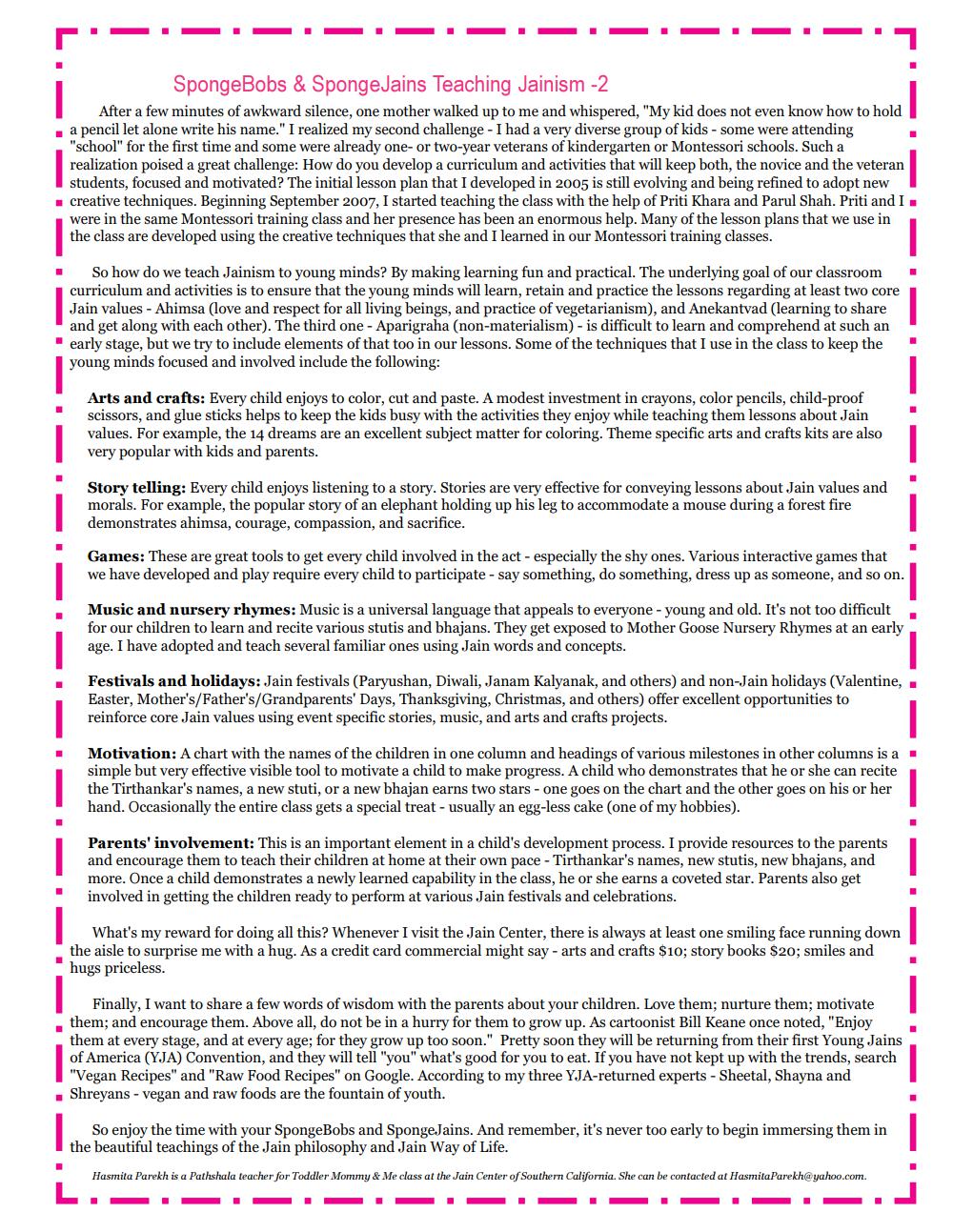________________
SpongeBobs & Sponge Jains Teaching Jainism -2 After a few minutes of awkward silence, one mother walked up to me and whispered, "My kid does not even know how to hold a pencil let alone write his name." I realized my second challenge - I had a very diverse group of kids - some were attending "school" for the first time and some were already one or two-year veterans of kindergarten or Montessori schools. Such a realization poised a great challenge: How do you develop a curriculum and activities that will keep both, the novice and the veteran
students, focused and motivated? The initial lesson plan that I developed in 2005 is still evolving and being refined to adopt new • creative techniques. Beginning September 2007, I started teaching the class with the help of Priti Khara and Parul Shah. Priti and I. were in the same Montessori training class and her presence has been an enormous help. Many of the lesson plans that we use in the class are developed using the creative techniques that she and I learned in our Montessori training classes.
So how do we teach Jainism to young minds? By making learning fun and practical. The underlying goal of our classroom curriculum and activities is to ensure that the young minds will learn, retain and practice the lessons regarding at least two core Jain values - Ahimsa (love and respect for all living beings, and practice of vegetarianism), and Anekantvad (learning to share and get along with each other). The third one - Aparigraha (non-materialism) - is difficult to learn and comprehend at such an early stage, but we try to include elements of that too in our lessons. Some of the techniques that I use in the class to keep the young minds focused and involved include the following:
Arts and crafts: Every child enjoys to color, cut and paste. A modest investment in crayons, color pencils, child-proof scissors, and glue sticks helps to keep the kids busy with the activities they enjoy while teaching them lessons about Jain values. For example, the 14 dreams are an excellent subject matter for coloring. Theme specific arts and crafts kits are also very popular with kids and parents.
Story telling: Every child enjoys listening to a story. Stories are very effective for conveying lessons about Jain values and morals. For example, the popular story of an elephant holding up his leg to accommodate a mouse during a forest fire demonstrates ahimsa, courage, compassion, and sacrifice.
Games: These are great tools to get every child involved in the act - especially the shy ones. Various interactive games that we have developed and play require every child to participate - say something, do something, dress up as someone, and so on.
Music and nursery rhymes: Music is a universal language that appeals to everyone - young and old. It's not too difficult for our children to learn and recite various stutis and bhajans. They get exposed to Mother Goose Nursery Rhymes at an early age. I have adopted and teach several familiar ones using Jain words and concepts.
Festivals and holidays: Jain festivals (Paryushan, Diwali, Janam Kalyanak, and others) and non-Jain holidays (Valentine, Easter, Mother's/Father's/Grandparents' Days, Thanksgiving, Christmas, and others) offer excellent opportunities to reinforce core Jain values using event specific stories, music, and arts and crafts projects.
Motivation: A chart with the names of the children in one column and headings of various milestones in other columns is a simple but very effective visible tool to motivate a child to make progress. A child who demonstrates that he or she can recite the Tirthankar's names, a new stuti, or a new bhajan earns two stars - one goes on the chart and the other goes on his or her hand. Occasionally the entire class gets a special treat - usually an egg-less cake (one of my hobbies).
Parents' involvement: This is an important element in a child's development process. I provide resources to the parents and encourage them to teach their children at home at their own pace - Tirthankar's names, new stutis, new bhajans, and more. Once a child demonstrates a newly learned capability in the class, he or she earns a coveted star. Parents also get involved in getting the children ready to perform at various Jain festivals and celebrations.
What's my reward for doing all this? Whenever I visit the Jain Center, there is always at least one smiling face running down the aisle to surprise me with a hug. As a credit card commercial might say - arts and crafts $10; story books $20; smiles and hugs priceless.
Finally, I want to share a few words of wisdom with the parents about your children. Love them; nurture them; motivate them; and encourage them. Above all, do not be in a hurry for them to grow up. As cartoonist Bill Keane once noted, "Enjoy them at every stage, and at every age; for they grow up too soon." Pretty soon they will be returning from their first Young Jains of America (YJA) Convention, and they will tell "you" what's good for you to eat. If you have not kept up with the trends, search "Vegan Recipes" and "Raw Food Recipes" on Google. According to my three YJA-returned experts - Sheetal, Shayna and Shreyans - vegan and raw foods are the fountain of youth.
So enjoy the time with your SpongeBobs and Sponge Jains. And remember, it's never too early to begin immersing them in the beautiful teachings of the Jain philosophy and Jain Way of Life.
Hasmita Parekh is a Pathshala teacher for Toddler Mommy & Me class at the Jain Center of Southern California. She can be contacted at Hasmita
[email protected].
